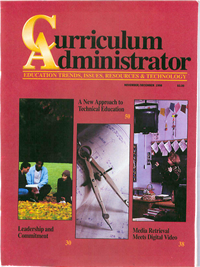
I have a special fondness for this article I wrote back in 1998. It was one of the first articles I wrote for Curriculum Administrator Magazine before enjoying a ten-year run as an Editor of its successor, District Administration. The article also chronicled some joyful work I did with students who demonstrated competence and good citizenship. This eleven year-old article also describes working in a laptop school (1:1 environment), the timeless hysteria over network security, the trustworthiness of students AND the article is about podcasting before podcasting was cool or even existed. In fact, few schools in the world were online at the time that these kids and I produced a digital radio show on the World Wide Web.
WADIO
Published in the November/December 1998 issue of Curriculum Administrator![]()
© 1998 – Gary S. Stager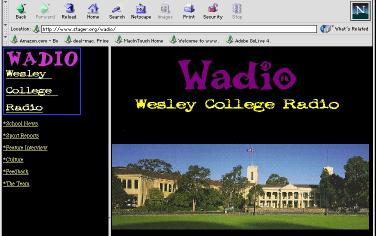
“Put on your virtual helmet and goggles! I’ve never tried this before and have no idea if we will be successful.” These cautionary words began my recent work with thirty-two eighth through tenth graders at Melbourne, Australia’s Wesley College.” I then explained to the unsuspecting students that we would spend the next four hours producing and broadcasting a digital radio program on the World Wide Web.
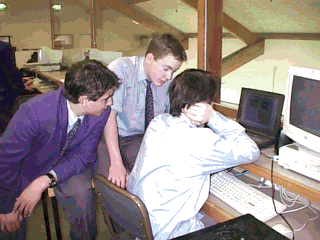 Radio provides a terrific vehicle for the development of writing, editing and oral communication skills without all of the technical vagaries associated with video production. Great radio requires great writing and RealAudio provides remarkably high transmission quality over the inadequate bandwidth found in most schools and homes. Low-cost digital technology allows every classroom to be a radio station.
Radio provides a terrific vehicle for the development of writing, editing and oral communication skills without all of the technical vagaries associated with video production. Great radio requires great writing and RealAudio provides remarkably high transmission quality over the inadequate bandwidth found in most schools and homes. Low-cost digital technology allows every classroom to be a radio station.
We began the session with a discussion of the advantages of streaming audio over traditional downloading and a bit about what compression is. Next, we brainstormed what sorts of information should be included in our school radio station. The kids determined that there should be school news, sports, music, movie and book reviews (later grouped as culture), feature interviews and a public opinion poll included in the broadcast.
I asked for five volunteers to comprise the team of web monkeys I anticipated would be needed to make everything work on the web. There were plenty of volunteers. (It seems that the more pejorative the title, the more workers you can attract.) We then asked kids to sign-up for the reporting team of their choice, trying to evenly distribute the students.
work on the web. There were plenty of volunteers. (It seems that the more pejorative the title, the more workers you can attract.) We then asked kids to sign-up for the reporting team of their choice, trying to evenly distribute the students.
My next instructions to the teams consisted of, “decide what sort of information you are going to broadcast, plan, write and record your piece of the program within the next hour.” The students displayed enormous maturity and self-direction in their efforts to decide how to make their piece of the program relevant and interesting. Many of them dispersed so they could conduct a poll, interview or collect other information on the campus. Their cooperative skills were tested when we were only able to find one audio tape recorder on the entire campus. Despite these obstacles, audio tapes poured in after morning tea.
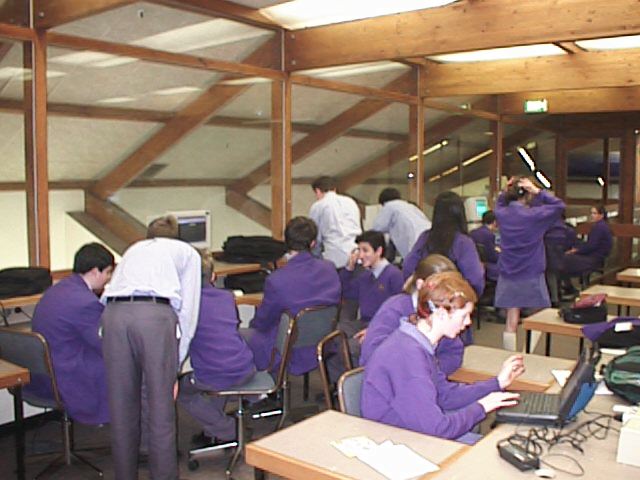 While the newly formed teams of producers, writers, directors and reporters fanned out across the campus, the web monkeys went to work. The first dilemma facing us was that I (the teacher) didn’t know how to stream audio files over the World Wide Web. I knew I had to use metafiles, but were not sure how they worked. Five copies of the documentation were made so I could ask my young colleagues to help me figure out the correct process. It didn’t take long before the idea of metafiles made sense. After overcoming that hurdle two kids began designing the web pages needed to contain the broadcast, while the others downloaded tools they would need to digitize and compress the audio. The rest of the team connected an audio deck to the computer and adjusted audio recording levels in anticipation of the arrival of the tapes. Kids even went out and snapped digital photos to include in the web site.
While the newly formed teams of producers, writers, directors and reporters fanned out across the campus, the web monkeys went to work. The first dilemma facing us was that I (the teacher) didn’t know how to stream audio files over the World Wide Web. I knew I had to use metafiles, but were not sure how they worked. Five copies of the documentation were made so I could ask my young colleagues to help me figure out the correct process. It didn’t take long before the idea of metafiles made sense. After overcoming that hurdle two kids began designing the web pages needed to contain the broadcast, while the others downloaded tools they would need to digitize and compress the audio. The rest of the team connected an audio deck to the computer and adjusted audio recording levels in anticipation of the arrival of the tapes. Kids even went out and snapped digital photos to include in the web site.
Things got a bit hectic when the reporting teams arrived with tapes in-hand. There seemed more than enough work to keep all thirty-two kids busy. One of the web monkeys quickly became dissatisfied with the quality of the school’s desktop computer so he took out his personal laptop and headphones and announced that he would digitize and compress all of the audio clips. A system for naming files was created, communicated and documented so everyone would be on the same page. Another member of the team cut, paste, saved and uploaded meta files to the appropriate server. While two kids continued designing the web site and one student took the initiative to be project manager for the entire process. He demonstrated extraordinary poise and leadership skills while keeping track of tapes, file names and quality control. I was able to bark shorthand instructions to him and he would ensure that the relevant people carried out the task.
By the end of the four hours a Wesley College School broadcast prototype was up and running on the web. We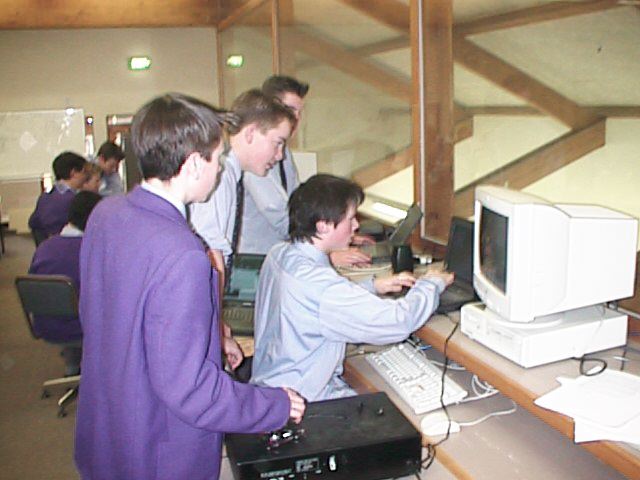 decided earlier in the day to call it WADIO. A bit less chaos, more time and more experience would have allowed all of the audio files to sound great. However, the kids did a remarkable job in a very short period of time. Their creativity, technical fluency and collaborative skills continue to inspire me. One group figured out that they could dub their music reviews over clips from the CD. The feature interview group decided that “everyone interviews the principal” so they proceeded to interview one of the cleaners and “tuck shop” (cafeteria) ladies. The most pleasant surprise was found on the culture page. The students not only reviewed popular music CDs and movies, but included an excellent review of George Orwell’s “Animal Farm.” Trusted with responsibility for their own learning, kids will often exceed our curricular expectations.
decided earlier in the day to call it WADIO. A bit less chaos, more time and more experience would have allowed all of the audio files to sound great. However, the kids did a remarkable job in a very short period of time. Their creativity, technical fluency and collaborative skills continue to inspire me. One group figured out that they could dub their music reviews over clips from the CD. The feature interview group decided that “everyone interviews the principal” so they proceeded to interview one of the cleaners and “tuck shop” (cafeteria) ladies. The most pleasant surprise was found on the culture page. The students not only reviewed popular music CDs and movies, but included an excellent review of George Orwell’s “Animal Farm.” Trusted with responsibility for their own learning, kids will often exceed our curricular expectations.
None of this would have been possible if the students did not possess the computing fluency that comes from each student having a personal laptop computer. It was easy to forget that I was working with kids as I asked them to find and download programs on the Internet, digitize and edit audio files, create web pages and upload all of their work to a remote file server. All of these seemingly complex processes were within the reach of these 13-16 year-olds.
A few lessons emerged for teachers and administrators concerned with managing technology and locking down computers.
- The students were able to produce a simple, yet technically complex streaming audio broadcast on the web in less than one school day. Perhaps existing models of computer literacy need to be reconsidered.
- The entire product was created with free and shareware tools.
- Despite a zillion dollars worth of school networking, the voice of Australian students was streaming from a server I pay $5/month for in Virginia, USA. Much of our email and web services could be subcontracted externally.
- Thirty two teenagers had access to my personal server password at all times. I never once feared that they would breach that trust for I treated them with respect and they were too busy being productive to be destructive. If the kids had violated my security, I could easily restore my files and change passwords. They are just computers.
- Information wants to be free. The immediate reaction of some school personnel was that the broadcast would run better if it were on the school’s Intranet. This is a big mistake. Kids should have as big an audience for their work as possible. Parents might want to listen from work. Students might want to know what time the football game starts from home and students on distant shores might be inspired by the work of peers halfway around the world.
- When involved in an purposeful educational project, students will remain engaged and create a quality of work that exceeds our expectations.
You may listen to the original audio production at this link (as long as the technology still works).
POSTSCRIPT – 2009
For several years I traveled the world sharing the story of WWWadio as an example of how the computer can be used to enhance personal expression and offer a global audience. Another lesson had to do with network security and student trustworthiness.
I gave all of the students my personal server username and password without fear for the following reasons:
1. They needed server access in order to do their work.
2. I was too busy teaching to constantly be interrupted in order to type a password into student computers.
3. I believed that if I trusted the students with my Web server, they would behave responsibly. Besides, the server was backed-up in case something went wrong.
4. The kids were so busy that they were likely to forget my password.
5. It’s just a damned server.
I never bothered to change the server password following the WWWadio class. At presentations I proudly proclaimed how the students did not harm my server, despite having root access. This was a stunning dose of reality for educators fearful and suspicious of children.
Then it happened…
One day, I found an unfamiliar folder residing on my Web server. Since I’m such a disorganized person, I just figured that I had accidentally created a folder or assumed that my service provider had placed it there.
Curious, I looked at the contents of that mystery folder through a Web browser. Surprise! The Australian private school students had been maintaining a school-related newspaper on my server somewhere in the United States for 2-3 years without my knowledge, and more importantly, without doing any damage to the server or any of its other contents.
That’s right, despite the high tuition fees the students paid, the fact that they every student has her own laptop AND the school’s millions of dollars worth of networking infrastructure and personnel, students found the school network unreliable or too difficult to use in a way that suited their needs.
It sure is a shame how much time, money and personnel schools spend on computer networks only to complicate or cripple them.
POSTSCRIPT – 2023
I remain convinced that storytelling is a powerful form of personal expression and knowledge construction. That said, the technical distractions afforded by graphics, video, and increasingly complex editing tools can diminish the literacy benefits derived principally from writing, speaking, and revising/editing. The phenomenal success of podcasting and radio, whether terrestrial, satellite, or Web-based is testament to the power and allure of the human voice. 2023 remains the golden age or “radio.”
Simply stated – audio remains a great vehicle for using one’s imagination, both as a storyteller and listener. It uses very little bandwidth and can be accomplished with inexpensive technology – thereby democratizing audio storytelling. Once a good story is produced, graphics, video, and animation may be added.
The following links should inspire great learning adventures for students or yourself.
- Student Voice shares deeply moving audio stories produced by my students incarcerated in a troubled prison for teens.
- Gamechanging AI Tools for Every Classroom is a free whitepaper, authored by yours truly, that introduces mind-blowing tools for supercharging your communication.
- My most recent collection of podcasts featuring me
Veteran educator Gary Stager, Ph.D. is the author of Twenty Things to Do with a Computer – Forward 50, co-author of Invent To Learn — Making, Tinkering, and Engineering in the Classroom, publisher at Constructing Modern Knowledge Press, and the founder of the Constructing Modern Knowledge summer institute. He led professional development in the world’s first 1:1 laptop schools thirty years ago and designed one of the oldest online graduate school programs. Gary is also the curator of The Seymour Papert archives at DailyPapert.com. Learn more about Gary here.
